What Are the Visual Characteristics of Post Modern Art?
Postmodern fine art is a trunk of art movements that sought to contradict some aspects of modernism or some aspects that emerged or adult in its aftermath. In general, movements such as intermedia, installation art, conceptual fine art and multimedia, particularly involving video are described every bit postmodern.
There are several characteristics which lend art to existence postmodern; these include bricolage, the use of text prominently every bit the central creative element, collage, simplification, appropriation, functioning art, the recycling of by styles and themes in a modern-day context, also every bit the break-up of the bulwark between fine and loftier arts and low fine art and popular culture.[1] [2]
Use of the term [edit]
The predominant term for fine art produced since the 1950s is "contemporary art". Not all art labeled as contemporary fine art is postmodern, and the broader term encompasses both artists who keep to work in modernist and late modernist traditions, too as artists who reject postmodernism for other reasons. Arthur Danto argues "contemporary" is the broader term, and postmodern objects represent a "subsector" of the contemporary motility.[3] Some postmodern artists have made more distinctive breaks from the ideas of modern art and there is no consensus every bit to what is "late-modern" and what is "postal service-mod." Ideas rejected by the modern artful take been re-established. In painting, postmodernism reintroduced representation.[4] Some critics fence much of the current "postmodern" art, the latest avant-gardism, should still classify as modern fine art.[5]
Every bit well as describing certain tendencies of contemporary fine art, postmodern has also been used to denote a phase of modern art. Defenders of modernism, such as Cloudless Greenberg,[half dozen] as well as radical opponents of modernism, such as Félix Guattari, who calls it modernism's "final gasp,[7]" have adopted this position. The neo-conservative Hilton Kramer describes postmodernism as "a creation of modernism at the terminate of its tether."[8] Jean-François Lyotard, in Fredric Jameson's analysis, does not concur at that place is a postmodern stage radically unlike from the menstruation of high modernism; instead, postmodern discontent with this or that high modernist style is office of the experimentation of high modernism, giving birth to new modernisms.[9] In the context of aesthetics and art, Jean-François Lyotard is a major philosopher of postmodernism.
Many critics concur postmodern fine art emerges from modern art. Suggested dates for the shift from modern to postmodern include 1914 in Europe,[ten] and 1962[xi] or 1968[12] in America. James Elkins, commenting on discussions about the exact date of the transition from modernism to postmodernism, compares it to the word in the 1960s about the exact span of Mannerism and whether it should begin straight afterward the High Renaissance or afterward in the century. He makes the point these debates go on all the time with respect to art movements and periods, which is not to say they are not important.[thirteen] The close of the period of postmodern art has been dated to the end of the 1980s, when the discussion postmodernism lost much of its critical resonance, and art practices began to address the impact of globalization and new media.[14]
Jean Baudrillard has had a significant influence on postmodern-inspired art and emphasised the possibilities of new forms of creativity.[15] The artist Peter Halley describes his 24-hour interval-glo colours equally "hyperrealization of real color", and acknowledges Baudrillard as an influence.[sixteen] Baudrillard himself, since 1984, was fairly consistent in his view contemporary fine art, and postmodern art in particular, was junior to the modernist fine art of the mail World War Ii menstruation,[16] while Jean-François Lyotard praised Contemporary painting and remarked on its development from Modernistic fine art.[17] Major Women artists in the Twentieth Century are associated with postmodern art since much theoretical articulation of their piece of work emerged from French psychoanalysis and Feminist Theory that is strongly related to post modernistic philosophy.[18] [xix]
American Marxist philosopher Fredric Jameson argues the status of life and production will be reflected in all action, including the making of fine art.
As with all uses of the term postmodern there are critics of its application. Kirk Varnedoe, for instance, stated that in that location is no such thing as postmodernism, and that the possibilities of modernism have not however been wearied.[20] Though the usage of the term as a kind of shorthand to designate the work of sure Post-war "schools" employing relatively specific material and generic techniques has become conventional since the mid-1980s, the theoretical underpinnings of Postmodernism equally an epochal or epistemic division are all the same very much in controversy.[21]
Defining postmodern art [edit]
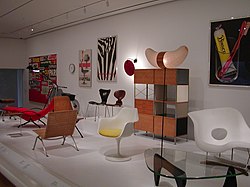
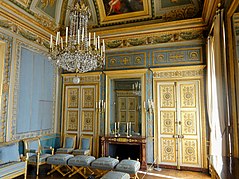
The juxtaposition of one-time and new, especially with regards to taking styles from past periods and re-fitting them into mod art outside of their original context, is a common characteristic of postmodern art.
Postmodernism describes movements which both arise from, and react against or reject, trends in modernism.[22] General citations for specific trends of modernism are formal purity, medium specificity, art for fine art's sake, actuality, universality, originality and revolutionary or reactionary tendency, i.e. the avant-garde. However, paradox is probably the most important modernist idea against which postmodernism reacts. Paradox was key to the modernist enterprise, which Manet introduced. Manet'due south various violations of representational art brought to prominence the supposed mutual exclusiveness of reality and representation, pattern and representation, brainchild and reality, so on. The incorporation of paradox was highly stimulating from Manet to the conceptualists.
The status of the avant-garde is controversial: many institutions argue existence visionary, forward-looking, cut-border, and progressive are crucial to the mission of art in the present, and therefore postmodern art contradicts the value of "art of our times". Postmodernism rejects the notion of advancement or progress in art per se, and thus aims to overturn the "myth of the avant-garde". Rosalind Krauss was 1 of the important enunciators of the view that avant-gardism was over, and the new artistic era is post-liberal and mail service-progress.[23] Griselda Pollock studied and confronted the avant-garde and modern art in a serial of groundbreaking books, reviewing modern art at the same time as redefining postmodern art.[24] [25] [26]
One characteristic of postmodern art is its conflation of high and low civilisation through the use of industrial materials and pop civilization imagery. The use of low forms of fine art were a part of modernist experimentation also, every bit documented in Kirk Varnedoe and Adam Gopnik's 1990–91 prove Loftier and Depression: Popular Civilisation and Modern Fine art at New York's Museum of Modernistic Fine art,[27] an exhibition that was universally panned at the time as the only issue that could bring Douglas Crimp and Hilton Kramer together in a chorus of scorn.[28] Postmodern art is noted for the way in which it blurs the distinctions between what is perceived equally fine or high art and what is by and large seen every bit low or kitsch art.[29] While this concept of "blurring" or "fusing" loftier fine art with depression art had been experimented during modernism, information technology merely always became fully endorsed after the advent of the postmodern era.[29] Postmodernism introduced elements of capitalism, kitsch and a full general campsite aesthetic within its artistic context; postmodernism takes styles from past periods, such as Gothicism, the Renaissance and the Baroque,[29] and mixes them so as to ignore their original use in their corresponding artistic move. Such elements are common characteristics of what defines postmodern art.
Fredric Jameson suggests postmodern works abjure whatever merits to spontaneity and directness of expression, making use instead of pastiche and discontinuity. Against this definition, Art and Language's Charles Harrison and Paul Wood maintained pastiche and aperture are endemic to modernist art, and are deployed effectively by modern artists such every bit Manet and Picasso.[30]
1 compact definition is postmodernism rejects modernism's grand narratives of artistic management, eradicating the boundaries between high and low forms of fine art, and disrupting genre's conventions with collision, collage, and fragmentation. Postmodern fine art holds all stances are unstable and insincere, and therefore irony, parody, and sense of humour are the simply positions critique or revision cannot overturn. "Pluralism and multifariousness" are other defining features.[31]
Avant-garde precursors [edit]
Radical movements and trends regarded as influential and potentially as precursors to postmodernism emerged around Earth War I and particularly in its aftermath. With the introduction of the use of industrial artifacts in art and techniques such as collage, avant-garde movements such as Cubism, Dada and Surrealism questioned the nature and value of art. New artforms, such as cinema and the rising of reproduction, influenced these movements equally a means of creating artworks. The ignition point for the definition of modernism, Cloudless Greenberg's essay, Advanced and Kitsch, commencement published in Partisan Review in 1939, defends the avant-garde in the face up of popular culture.[32] Later, Peter Bürger would make a distinction between the historical advanced and modernism, and critics such as Krauss, Huyssen, and Douglas Crimp, following Bürger, identified the historical avant-garde as a precursor to postmodernism. Krauss, for example, describes Pablo Picasso's use of collage as an avant-garde practice anticipating postmodern fine art with its emphasis on language at the expense of autobiography.[33] Another betoken of view is avant-garde and modernist artists used like strategies and postmodernism repudiates both.[34]
Dada [edit]
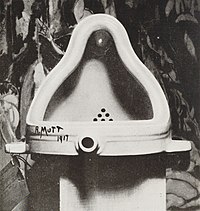
In the early 20th century Marcel Duchamp exhibited a urinal as a sculpture. His betoken was to have people look at the urinal as if it were a work of art just because he said it was a work of art.[35] [36] [37] He referred to his piece of work every bit "Readymades".[38] The Fountain was a urinal signed with the pseudonym R. Mutt, which shocked the art globe in 1917.[39] This and Duchamp'south other works are generally labelled as Dada. Duchamp tin can be seen equally a precursor to conceptual art. Some critics question calling Duchamp—whose obsession with paradox is well known—postmodernist on the grounds he eschews any specific medium, since paradox is not medium-specific, although it arose first in Manet'due south paintings.[forty]
Dadaism can be viewed as part of the modernist propensity to challenge established styles and forms, forth with Surrealism, Futurism and Abstract Expressionism.[41] From a chronological point of view, Dada is located solidly within modernism, yet a number of critics hold it anticipates postmodernism, while others, such equally Ihab Hassan and Steven Connor, consider it a possible changeover betoken between modernism and postmodernism.[42] For instance, co-ordinate to McEvilly, postmodernism begins with realizing ane no longer believes in the myth of progress, and Duchamp sensed this in 1914 when he inverse from a modernist do to a postmodernist i, "abjuring aesthetic delectation, transcendent ambition, and tour de force demonstrations of formal agility in favor of artful indifference, acknowledgement of the ordinary world, and the constitute object or readymade."[10]
Radical movements in modernistic art [edit]
In general, Pop Art and Minimalism began as modernist movements: a paradigm shift and philosophical separate between ceremonial and anti-formalism in the early 1970s acquired those movements to be viewed by some as precursors or transitional postmodern art. Other modern movements cited as influential to postmodern art are conceptual art and the apply of techniques such as aggregation, montage, bricolage, and cribbing.
Jackson Pollock and abstract expressionism [edit]
During the late 1940s and early 1950s, Pollock's radical approach to painting revolutionized the potential for all Gimmicky art following him. Pollock realized the journey toward making a work of art was every bit important as the work of art itself. Like Pablo Picasso'due south innovative reinventions of painting and sculpture near the turn of the century via Cubism and constructed sculpture, Pollock redefined artmaking during the mid-century. Pollock's motion from easel painting and conventionality liberated his contemporaneous artists and following artists. They realized Pollock's procedure — working on the floor, unstretched raw canvas, from all 4 sides, using artist materials, industrial materials, imagery, non-imagery, throwing linear skeins of paint, dripping, drawing, staining, brushing - blasted artmaking beyond prior boundaries. Abstract expressionism expanded and developed the definitions and possibilities artists had available for the creation of new works of art. In a sense, the innovations of Jackson Pollock, Willem de Kooning, Franz Kline, Mark Rothko, Philip Guston, Hans Hofmann, Clyfford Withal, Barnett Newman, Advertizing Reinhardt and others, opened the floodgates to the diversity and scope of following artworks.[43]
After abstract expressionism [edit]
In abstract painting during the 1950s and 1960s several new directions like Hard-edge painting and other forms of Geometric abstraction like the work of Frank Stella popped up, every bit a reaction against the subjectivism of Abstract expressionism began to appear in artist studios and in radical avant-garde circles. Clement Greenberg became the vox of Post-painterly brainchild; by curating an influential exhibition of new painting touring important art museums throughout the United States in 1964. Colour field painting, Difficult-edge painting and Lyrical Abstraction[44] emerged as radical new directions.
By the tardily 1960s, Postminimalism, Process Fine art and Arte Povera[45] besides emerged as revolutionary concepts and movements encompassing painting and sculpture, via Lyrical Abstraction and the Postminimalist movement, and in early Conceptual Art.[45] Process art as inspired by Pollock enabled artists to experiment with and make use of a diverse encyclopedia of style, content, fabric, placement, sense of time, and plastic and real space. Nancy Graves, Ronald Davis, Howard Hodgkin, Larry Poons, Jannis Kounellis, Brice Marden, Bruce Nauman, Richard Tuttle, Alan Saret, Walter Darby Bannard, Lynda Benglis, Dan Christensen, Larry Zox, Ronnie Landfield, Eva Hesse, Keith Sonnier, Richard Serra, Sam Gilliam, Mario Merz, Peter Reginato, Lee Lozano, were some of the younger artists emerging during the era of tardily modernism spawning the heyday of the art of the late 1960s.[46]
Performance art and happenings [edit]
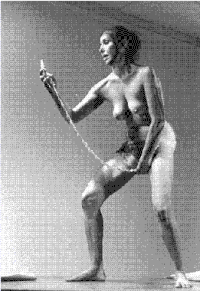
During the tardily 1950s and 1960s, artists with a broad range of interests began pushing the boundaries of Gimmicky art. Yves Klein in France, and Carolee Schneemann, Yayoi Kusama, Charlotte Moorman, and Yoko Ono in New York City were pioneers of performance based works of art. Groups like The Living Theater with Julian Beck and Judith Malina collaborated with sculptors and painters creating environments; radically irresolute the relationship between audition and performer specially in their piece Paradise At present.[48] [49] The Judson Dance Theater located at the Judson Memorial Church, New York, and the Judson dancers, notably Yvonne Rainer, Trisha Dark-brown, Elaine Summers, Emerge Gross, Simonne Forti, Deborah Hay, Lucinda Childs, Steve Paxton and others collaborated with artists Robert Morris, Robert Whitman, John Cage, Robert Rauschenberg, and engineers like Billy Klüver.[fifty] These performances were frequently designed to be the creation of a new fine art course, combining sculpture, trip the light fantastic toe, and music or sound, ofttimes with audience participation. The reductive philosophies of minimalism, spontaneous improvisation, and expressivity of Abstract expressionism characterized the works.[51]
During the same period — the late 1950s through the mid-1960s - diverse avant-garde artists created Happenings. Happenings were mysterious and ofttimes spontaneous and unscripted gatherings of artists and their friends and relatives in varied specified locations. Often incorporating exercises in absurdity, concrete do, costumes, spontaneous nudity, and various random and seemingly disconnected acts. Allan Kaprow, Joseph Beuys, Nam June Paik, Wolf Vostell, Claes Oldenburg, Jim Dine, Ruddy Grooms, and Robert Whitman among others were notable creators of Happenings.[52]
Aggregation art [edit]
Related to Abstract expressionism was the emergence of combined manufactured items — with creative person materials, moving away from previous conventions of painting and sculpture. The work of Robert Rauschenberg, whose "combines" in the 1950s were forerunners of Pop Art and Installation art, and made use of the aggregation of large physical objects, including stuffed animals, birds and commercial photography, exemplified this art trend.[ commendation needed ]
Leo Steinberg uses the term postmodernism in 1969 to describe Rauschenberg'due south "flatbed" picture aeroplane, containing a range of cultural images and artifacts that had non been uniform with the pictorial field of premodernist and modernist painting.[53] Craig Owens goes further, identifying the significance of Rauschenberg's piece of work not as a representation of, in Steinberg's view, "the shift from nature to culture", but every bit a demonstration of the impossibility of accepting their opposition.[54]
Steven Best and Douglas Kellner identify Rauschenberg and Jasper Johns as part of the transitional phase, influenced past Marcel Duchamp, between modernism and postmodernism. These artists used images of ordinary objects, or the objects themselves, in their work, while retaining the abstraction and painterly gestures of high modernism.[55]
Anselm Kiefer also uses elements of assemblage in his works, and on one occasion, featured the bow of a fishing gunkhole in a painting.
Popular art [edit]
Lawrence Alloway used the term "Pop art" to depict paintings celebrating consumerism of the mail service Globe War Ii era. This motion rejected Abstract expressionism and its focus on the hermeneutic and psychological interior, in favor of fine art which depicted, and often celebrated, material consumer culture, advertising, and iconography of the mass product age. The early on works of David Hockney and the works of Richard Hamilton, John McHale, and Eduardo Paolozzi were considered seminal examples in the motion. While later on American examples include the bulk of the careers of Andy Warhol and Roy Lichtenstein and his use of Benday dots, a technique used in commercial reproduction. In that location is a clear connection between the radical works of Duchamp, the rebellious Dadaist — with a humour; and Pop Artists like Claes Oldenburg, Andy Warhol, Roy Lichtenstein and the others.
Thomas McEvilly, agreeing with Dave Hickey, says U.S postmodernism in the visual arts began with the kickoff exhibitions of Pop art in 1962, "though it took about twenty years before postmodernism became a ascendant attitude in the visual arts."[11] Fredric Jameson, too, considers pop art to be postmodern.[56]
Ane fashion Pop art is postmodern is it breaks down what Andreas Huyssen calls the "Not bad Divide" between high art and popular civilization.[57] Postmodernism emerges from a "generational refusal of the categorical certainties of high modernism."[58]
Fluxus [edit]

Solo For Violin • Polishing as performed by George Brecht, New York, 1964. Photo by G Maciunas
Fluxus was named and loosely organized in 1962 by George Maciunas (1931–78), a Lithuanian-born American artist. Fluxus traces its beginnings to John Cage'southward 1957 to 1959 Experimental Limerick classes at the New Schoolhouse for Social Research in New York City. Many of his students were artists working in other media with little or no background in music. Cage's students included Fluxus founding members Jackson Mac Low, Al Hansen, George Brecht and Dick Higgins. In 1962 in Germany Fluxus started with the: FLUXUS Internationale Festspiele Neuester Musik in Wiesbaden with, George Maciunas, Joseph Beuys, Wolf Vostell, Nam June Paik and others. And in 1963 with the: Festum Fluxorum Fluxus in Düsseldorf with George Maciunas, Wolf Vostell, Joseph Beuys, Dick Higgins, Nam June Paik, Ben Patterson, Emmett Williams and others.[ citation needed ]
Fluxus encouraged a practise it yourself aesthetic, and valued simplicity over complexity. Like Dada before it, Fluxus included a potent electric current of anti-capitalism and an anti-fine art sensibility, disparaging the conventional market place-driven art globe in favor of an creative person-centered creative practice. Fluxus artists preferred to piece of work with any materials were at hand, and either created their own work or collaborated in the creation process with their colleagues.
Fluxus tin can be viewed as function of the first phase of postmodernism, along with Rauschenberg, Johns, Warhol and the Situationist International.[59] Andreas Huyssen criticises attempts to claim Fluxus for postmodernism as, "either the master-code of postmodernism or the ultimately unrepresentable fine art movement – every bit it were, postmodernism's sublime." Instead he sees Fluxus every bit a major Neo-Dadaist phenomena within the avant-garde tradition. It did not represent a major advance in the development of artistic strategies, though it did express a rebellion against, "the administered civilization of the 1950s, in which a moderate, domesticated modernism served as ideological prop to the Cold War."[60]
Minimalism [edit]

By the early 1960s Minimalism emerged as an abstract movement in fine art (with roots in geometric brainchild via Malevich, the Bauhaus and Mondrian) which rejected the thought of relational, and subjective painting, the complexity of Abstract expressionist surfaces, and the emotional zeitgeist and polemics present in the arena of Activeness painting. Minimalism argued extreme simplicity could capture the sublime representation fine art requires. Associated with painters such every bit Frank Stella, minimalism in painting, as opposed to other areas, is a modernist movement and depending on the context tin be construed equally a precursor to the postmodern movement.
Hal Foster, in his essay The Crux of Minimalism, examines the extent to which Donald Judd and Robert Morris both acknowledge and exceed Greenbergian modernism in their published definitions of minimalism.[61] He argues minimalism is non a "dead terminate" of modernism, only a "paradigm shift toward postmodern practices that continue to be elaborated today."[62]
Postminimalism [edit]
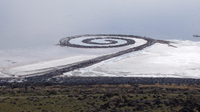
Robert Pincus-Witten coined the term Mail service-minimalism in 1977 to describe minimalist derived art which had content and contextual overtones minimalism rejected. His employ of the term covered the period 1966 – 1976 and practical to the work of Eva Hesse, Keith Sonnier, Richard Serra and new work by one-time minimalists Robert Smithson, Robert Morris, Sol LeWitt, and Barry Le Va, and others.[45] Process art and anti-form fine art are other terms describing this work, which the space it occupies and the process by which information technology is made determines.[63]
Rosalind Krauss argues by 1968 artists such every bit Morris, LeWitt, Smithson and Serra had "entered a situation the logical conditions of which can no longer be described as modernist."[12] The expansion of the category of sculpture to include land art and architecture, "brought most the shift into postmodernism."[64]
Minimalists similar Donald Judd, Dan Flavin, Carl Andre, Agnes Martin, John McCracken and others continued to produce their late modernist paintings and sculpture for the remainder of their careers.
Movements in postmodern art [edit]
Conceptual art [edit]
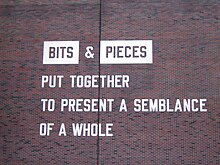
Lawrence Weiner, Bits & Pieces Put Together to Nowadays a Semblance of a Whole, The Walker Art Center, Minneapolis, 2005.
Conceptual art is sometimes labelled as postmodern because it is expressly involved in deconstruction of what makes a work of art, "art". Conceptual art, because it is often designed to confront, offend or attack notions held past many of the people who view it, is regarded with particular controversy.
Precursors to conceptual fine art include the work of Duchamp, John Cage's 4' 33", in which the music is said to be "the sounds of the environment that the listeners' hear while information technology is performed," and Rauschenberg's Erased De Kooning Cartoon. Many conceptual works take the position that art is created by the viewer viewing an object or human action as art, not from the intrinsic qualities of the work itself. Thus, considering Fountain was exhibited, it was a sculpture.
Installation art [edit]
An important series of movements in art which have consistently been described every bit postmodern involved installation art and cosmos of artifacts that are conceptual in nature. One example beingness the signs of Jenny Holzer which use the devices of art to convey specific messages, such as "Protect Me From What I Desire". Installation Fine art has been important in determining the spaces selected for museums of contemporary art in order to be able to hold the large works which are composed of vast collages of manufactured and establish objects. These installations and collages are often electrified, with moving parts and lights.
They are often designed to create ecology effects, as Christo and Jeanne-Claude's Iron Curtain, Wall of 240 Oil Barrels, Blocking Rue Visconti, Paris, June 1962 which was a poetic response to the Berlin Wall built in 1961.
Lowbrow fine art [edit]
Lowbrow is a widespread populist art movement with origins in the underground comix earth, punk music, hot-rod street culture, and other California subcultures. Information technology is also often known past the proper name pop surrealism. Lowbrow art highlights a key theme in postmodernism in that the distinction between "high" and "depression" art are no longer recognized.
Operation art [edit]
Digital fine art [edit]

Joseph Nechvatal birth Of the viractual 2001 reckoner-robotic assisted acrylic on canvass
Digital fine art is a full general term for a range of creative works and practices that use digital technology as an essential office of the artistic and/or presentation procedure. The bear on of digital technology has transformed activities such as painting, drawing, sculpture and music/sound art, while new forms, such as net art, digital installation art, and virtual reality, accept become recognized artistic practices.
Leading art theorists and historians in this field include Christiane Paul, Frank Popper, Christine Buci-Glucksmann, Dominique Moulon, Robert C. Morgan, Roy Ascott, Catherine Perret, Margot Lovejoy, Edmond Couchot, Fred Forest and Edward A. Shanken.
Intermedia and multi-media [edit]
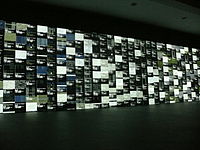
Another trend in fine art which has been associated with the term postmodern is the utilise of a number of different media together. Intermedia, a term coined past Dick Higgins and meant to convey new artforms along the lines of Fluxus, Concrete Poesy, Found objects, Performance art, and Computer fine art. Higgins was the publisher of the Something Else Press, a Concrete poet, married to artist Alison Knowles and an gentleman of Marcel Duchamp. Ihab Hassan includes, "Intermedia, the fusion of forms, the confusion of realms," in his list of the characteristics of postmodern art.[65] One of the most common forms of "multi-media fine art" is the use of video-tape and CRT monitors, termed Video art. While the theory of combining multiple arts into 1 art is quite old, and has been revived periodically, the postmodern manifestation is oft in combination with operation fine art, where the dramatic subtext is removed, and what is left is the specific statements of the artist in question or the conceptual statement of their action. Higgin'due south conception of Intermedia is continued to the growth of multimedia digital practise such every bit immersive virtual reality, digital fine art and computer art.
Telematic Art [edit]
Telematic art is a descriptive of art projects using computer mediated telecommunications networks as their medium. Telematic art challenges the traditional relationship between active viewing subjects and passive art objects past creating interactive, behavioural contexts for remote aesthetic encounters. Roy Ascott sees the telematic art form as the transformation of the viewer into an active participator of creating the artwork which remains in process throughout its duration. Ascott has been at the forefront of the theory and practice of telematic art since 1978 when he went online for the starting time time, organizing different collaborative online projects.
Cribbing fine art and neo-conceptual art [edit]
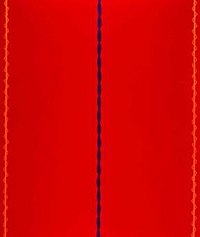
In his 1980 essay The Allegorical Impulse: Toward a Theory of Postmodernism, Craig Owens identifies the re-emergence of an allegorical impulse every bit characteristic of postmodern fine art. This impulse can exist seen in the appropriation fine art of artists such every bit Sherrie Levine and Robert Longo because, "Allegorical imagery is appropriated imagery."[66] Appropriation art debunks modernist notions of creative genius and originality and is more clashing and contradictory than modern art, simultaneously installing and subverting ideologies, "being both critical and complicit."[67]
Neo-expressionism and painting [edit]
The return to the traditional art forms of sculpture and painting in the late 1970s and early 1980s seen in the work of Neo-expressionist artists such equally Georg Baselitz and Julian Schnabel has been described as a postmodern trend,[68] and one of the first coherent movements to emerge in the postmodern era.[69] Its strong links with the commercial art market has raised questions, yet, both about its status equally a postmodern movement and the definition of postmodernism itself. Hal Foster states that neo-expressionism was complicit with the conservative cultural politics of the Reagan-Bush era in the U.South.[62] Félix Guattari disregards the "big promotional operations dubbed 'neo-expressionism' in Federal republic of germany," (an example of a "fad that maintains itself by means of publicity") as a too easy way for him "to demonstrate that postmodernism is nothing simply the final gasp of modernism."[vii] These critiques of neo-expressionism reveal that money and public relations really sustained contemporary art world credibility in America during the same flow that conceptual artists, and practices of women artists including painters and feminist theorists like Griselda Pollock,[seventy] [71] were systematically reevaluating modern art.[72] [73] [74] Brian Massumi claims that Deleuze and Guattari open up the horizon of new definitions of Beauty in postmodern art.[75] For Jean-François Lyotard, information technology was painting of the artists Valerio Adami, Daniel Buren, Marcel Duchamp, Bracha Ettinger, and Barnett Newman that, after the advanced's time and the painting of Paul Cézanne and Wassily Kandinsky, was the vehicle for new ideas of the sublime in contemporary art.[76] [77]
Institutional critique [edit]
Critiques on the institutions of art (principally museums and galleries) are fabricated in the work of Michael Asher, Marcel Broodthaers, Daniel Buren and Hans Haacke.
See also [edit]
- Anti-fine art
- Anti-anti-art
- Classificatory disputes nigh art
- Cyborg fine art
- Electronic art
- Experiments in Fine art and Technology
- Gaze
- Late Modernism
- Modern art
- Modernist project
- Neo-minimalism
- Net.art
- New European Painting
- New Media art
- Mail-conceptual
- Superflat
- Superstroke
- Remodernism
- Irving Sandler
- Virtual fine art
Sources [edit]
- The Triumph of Modernism: The Art Globe, 1985–2005, Hilton Kramer, 2006, ISBN 978-0-15-666370-0
- Pictures of Nothing: Abstruse Art since Pollock (A.Westward. Mellon Lectures in the Fine Arts), Kirk Varnedoe, 2003
- Art of the Postmodern Era: From the Belatedly 1960s to the Early 1990s, Irving Sandler
- Postmodernism (Movements in Modern Art) Eleanor Heartney
- Sculpture in the Age of Doubtfulness Thomas McEvilley 1999
References [edit]
- ^ Ideas Most Art, Desmond, Kathleen K. [1] John Wiley & Sons, 2011, p.148
- ^ International postmodernism: theory and literary practice, Bertens, Hans [ii], Routledge, 1997, p.236
- ^ After the End of Art: Gimmicky Art and the Stake of History Arthur C. Danto
- ^ Wendy Steiner, Venus in Exile: The Rejection of Beauty in 20th-Century Art, New York: The Costless Printing, 2001, ISBN 978-0-684-85781-7
- ^ Post-Modernism: The New Classicism in Fine art and Architecture Charles Jencks
- ^ Cloudless Greenberg: Modernism and Postmodernism, 1979. Retrieved June 26, 2007.
- ^ a b Félix Guattari, the Postmodern Impasse in The Guattari Reader, Blackwell Publishing, 1996, pp109-113. ISBN 978-0-631-19708-ix
- ^ Quoted in Oliver Bennett, Cultural Pessimism: Narratives of Decline in the Postmodern World, Edinburgh University Press, 2001, p131. ISBN 978-0-7486-0936-9
- ^ Fredric Jameson, Foreword to Jean-François Lyotard, The Postmodern Condition, Manchester University Press, 1997, pxvi. ISBN 978-0-7190-1450-five
- ^ a b Thomas McEvilly in Richard Roth, Jean Dubuffet, Susan Rex, Dazzler Is Nowhere: Ethical Issues in Art and Design, Routledge, 1998. p27. ISBN 978-90-5701-311-9
- ^ a b Thomas McEvilly in Richard Roth, Jean Dubuffet, Susan King, Beauty Is Nowhere: Ethical Bug in Art and Pattern, Routledge, 1998. p29. ISBN 978-90-5701-311-9
- ^ a b The Originality of the Avant Garde and Other Modernist Myths Rosalind Eastward. Krauss, Publisher: The MIT Press; Reprint edition (July 9, 1986), Sculpture in the Expanded Field pp.287
- ^ James Elkins, Stories of Art, Routledge, 2002, p16. ISBN 978-0-415-93942-three
- ^ Zoya Kocur and Simon Leung, Theory in Gimmicky Art Since 1985, Blackwell Publishing, 2005, pp2-iii. ISBN 978-0-631-22867-7
- ^ Nicholas Zurbrugg, Jean Baudrillard, Jean Baudrillard: Fine art and Artefact, Sage Publications, 1997, p150. ISBN 978-0-7619-5580-1
- ^ a b Gary Genosko, Baudrillard and Signs: Signification Ablaze, Routledge, 1994, p154. ISBN 978-0-415-11256-7
- ^ Grebowicz, Margaret, Gender Later on Lyotard, Country University of New York Press, 2007. ISBN 978-0-7914-6956-nine
- ^ de Zegher, Catherine (ed.) Inside the Visible, MIT Press, 1996
- ^ Armstrong, Ballad and de Zegher, Catherine, Women Artists at the Millennium, Oct Books / The MIT Press, 2006, ISBN 978-0-262-01226-3
- ^ William R. Everdell, The First Moderns: Profiles in the Origins of Twentieth-century Thought, University of Chicago Press, 1997, p4. ISBN 978-0-226-22480-0
- ^ The Citadel of Modernism Falls to Deconstructionists, – 1992 critical essay, The Triumph of Modernism, 2006, Hilton Kramer, pp218-221.
- ^ The Originality of the Avant Garde and Other Modernist Myths Rosalind Due east. Krauss, Publisher: The MIT Press; Reprint edition (July 9, 1986), Function I, Modernist Myths, pp.8–171
- ^ The Originality of the Avant Garde and Other Modernist Myths Rosalind E. Krauss, Publisher: The MIT Press; Reprint edition (July 9, 1986), Function I, Modernist Myths, pp.8–171, Part Two, Toward Post-modernism, pp. 196–291.
- ^ Fred Orton and Griselda Pollock, Avant-Gardes and Partisans reviewed. Manchester Academy Press, 1996. ISBN 978-0-7190-4399-4.
- ^ Griselda Pollock, Differencing the Canon. Routledge, London & North.Y., 1999. ISBN 978-0-415-06700-three.
- ^ Griselda Pollock, Generations and Geographies in the Visual Arts. Routledge, London, 1996. ISBN 978-0-415-14128-4.
- ^ Maria DiBattista and Lucy McDiarmid, Loftier and Depression Moderns: literature and culture, 1889–1939, Oxford University Printing, 1996, pp6-vii. ISBN 978-0-nineteen-508266-i
- ^ Kirk Varnedoe, 1946–2003 – Front end Page – Obituary – Art in America, Oct, 2003 by Marcia East. Vetrocq
- ^ a b c General Introduction to Postmodernism. Cla.purdue.edu. Retrieved on 2013-08-02.
- ^ Charles Harrison and Paul Wood, Art in Theory, 1900–2000: An Anthology of Irresolute Ideas, Blackwell Publishing, 1992, p1014. ISBN 978-0-631-22708-3
- ^ Michael Woods: Art of the Western World, Summit Books, 1989, p323. ISBN 978-0-671-67007-8
- ^ Avant-Garde and Kitsch
- ^ Rosalind Eastward. Krauss, In the Name of Picasso in The Originality of the Avant-Garde and other Modernist Myths, MIT Press, 1985, p39. ISBN 978-0-262-61046-9
- ^ John P. McGowan, Postmodernism and its Critics, Cornell University Press, 1991, p10. ISBN 978-0-8014-2494-6
- ^ "Fountain, Marcel Duchamp, 1917, replica, 1964". tate.org.uk. Tate. Retrieved 5 Oct 2018.
- ^ Gavin Parkinson, The Duchamp Book: Tate Essential Artists Serial, Harry N. Abrams, 2008, p. 61, ISBN 1854377663
- ^ Dalia Judovitz, Unpacking Duchamp: Art in Transit, University of California Press, 1998, pp. 124, 133, ISBN 0520213769
- ^ Tomkins: Duchamp: A Biography, folio 158.
- ^ William A. Camfield, Marcel Duchamp's Fountain, Its History and Aesthetics in the Context of 1917 (Function i), Dada/Surrealism 16 (1987): pp. 64-94.
- ^ THE INVENTION OF NON-Art: A HISTORY ArtForum International
- ^ Simon Malpas, The Postmodern, Routledge, 2005. p17. ISBN 978-0-415-28064-8
- ^ Mark A. Pegrum, Challenging Modernity: Dada Between Modern and Postmodern, Berghahn Books, 2000, pp2-iii. ISBN 978-1-57181-130-i
- ^ De Zegher, Catherine, and Teicher, Hendel (eds.), 3 Ten Brainchild. New Oasis: Yale Academy Press. 2005.
- ^ Aldrich, Larry. Young Lyrical Painters, Art in America, 5.57, n6, November–December 1969, pp.104–113.
- ^ a b c Movers and Shakers, New York, "Leaving C&Thousand", by Sarah Douglas, Art and Sale, March 2007, V.XXXNo7.
- ^ Martin, Ann Ray, and Howard Junker. The New Art: It's Manner, Style Out, Newsweek 29 July 1968: pp.iii,55–63.
- ^ Interior Scroll, 1975. Carolee Schneemann. Retrieved on 2013-08-02.
- ^ [The Living Theatre (1971). Paradise Now. New York: Random Business firm.]
- ^ Gary Botting, The Theatre of Protestation in America, Edmonton: Harden House, 1972.
- ^ [Janevsky, Ana and Lax, Thomas (2018) Judson Trip the light fantastic Theater: The Piece of work Is Never Done (exhibition catalog) New York: Museum of Modern Art. ISBN 978-1-63345-063-9]
- ^ [Banes, Sally (1993) Republic's Body: Judson Dance Theater, 1962-1964. Durham, N Carolina: Duke Academy Press. ISBN 0-8223-1399-5]
- ^ Michael Kirby, Happenings: An Illustrated Album, scripts and productions by Jim Dine, Reddish Grooms, Allan Kaprow, Claes Oldenburg, Robert Whitman (New York: E. P. Dutton & Co., Inc., 1965), p. 21.
- ^ Douglas Crimp in Hal Foster (ed), Postmodern Civilisation, Pluto Press, 1985 (kickoff published every bit The Anti-Aesthetic, 1983). p44. ISBN 978-0-7453-0003-0
- ^ Craig Owens, Beyond Recognition: Representation, Power, and Civilization, London and Berkeley: Academy of California Press (1992), pp74-75.
- ^ Steven Best, Douglas Kellner, The Postmodern Turn, Guilford Press, 1997, p174. ISBN 978-1-57230-221-ane
- ^ Fredric Jameson in Hal Foster, Postmodern Civilization, Pluto Printing, 1985 (first published as The Anti-Aesthetic, 1983). p111. ISBN 978-0-7453-0003-0
- ^ Simon Malpas, The Postmodern, Routledge, 2005. p20. ISBN 978-0-415-28064-8
- ^ Stuart Sim, The Routledge Companion to Postmodernism, Routledge, 2001. p148. ISBN 978-0-415-24307-0
- ^ Richard Sheppard, Modernism-Dada-Postmodernism, Northwestern Academy Printing, 2000. p359. ISBN 978-0-8101-1492-0
- ^ Andreas Huyssen, Twilight Memories: Marking Time in a Civilisation of Amnesia, Routledge, 1995. p192, p196. ISBN 978-0-415-90934-one
- ^ Hal Foster, The Return of the Real: The Avant-garde at the Stop of the Century, MIT Press, 1996, pp44-53. ISBN 978-0-262-56107-v
- ^ a b Hal Foster, The Return of the Real: The Advanced at the End of the Century, MIT Press, 1996, p36. ISBN 978-0-262-56107-five
- ^ Erika Doss, Twentieth-Century American Art, Oxford University Printing, 2002, p174. ISBN 978-0-19-284239-eight
- ^ The Originality of the Avant Garde and Other Modernist Myths Rosalind E. Krauss, Publisher: The MIT Press; Reprint edition (July nine, 1986), Sculpture in the Expanded Field (1979). pp.290
- ^ Ihab Hassan in Lawrence Due east. Cahoone, From Modernism to Postmodernism: An Anthology, Blackwell Publishing, 2003. p13. ISBN 978-0-631-23213-one
- ^ Craig Owens, Beyond Recognition: Representation, Ability, and Culture, London and Berkeley: University of California Printing (1992), p54
- ^ Steven Best and Douglas Kellner, The Postmodern Turn, Guilford Press, 1997. p186. ISBN 978-one-57230-221-i
- ^ Tim Woods, Beginning Postmodernism, Manchester University Press, 1999. p125. ISBN 978-0-7190-5211-8
- ^ Fred S. Kleiner, Christin J. Mamiya, Gardner'south Art Through the Ages: The Western Perspective, Thomson Wadsworth, 2006, p842. ISBN 978-0-495-00480-6
- ^ Griselda Pollock & Penny Florence, Looking Back to the Future: Essays by Griselda Pollock from the 1990s. New York: One thousand&B New Arts Press, 2001. ISBN 978-ninety-5701-132-0
- ^ Griselda Pollock, Generations and Geographies in the Visual Arts, Routledge, London, 1996. ISBN 978-0-415-14128-4
- ^ Erika Doss, Twentieth-Century American Art, Oxford University Press, 2002, p210. ISBN 978-0-19-284239-8
- ^ Lyotard, Jean-François (1993), Scriptures: Diffracted Traces, reprinted in: Theory, Civilization and Club, Book 21 Number i, 2004. ISSN 0263-2764
- ^ Pollock, Griselda, Inscriptions in the Feminine, in: de Zegher, Catherine, Ed.) Inside the Visible. Massachusetts: MIT Press, 1996
- ^ Massumi, Brian (ed.), A Shock to Thought: Expression after Deleuze and Guattari. London: Routledge, 2002. ISBN 978-0-415-23804-5
- ^ Buci-Glucksmann, Christine, "Le differend de l'art". In: Jean-François Lyotard: L'exercise du differend. Paris: PUF, 2001. ISBN 978-2-thirteen-051056-7
- ^ Lyotard, Jean-François, "L'anamnese". In: Dr. and Patient: Retentiveness and Amnesia. Porin Taidemuseo,1996. ISBN 978-951-9355-55-9. Reprinted every bit: Lyotard, Jean-François, "Anamnesis: Of the Visible." In: Theory, Civilisation and Club, Vol. 21(one), 2004. 0263–2764
External links [edit]
-
 Media related to Postmodern art at Wikimedia Commons
Media related to Postmodern art at Wikimedia Commons
Source: https://en.wikipedia.org/wiki/Postmodern_art